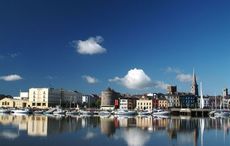Waveriders, the acclaimed documentary directed by Dublin native Joel Conroy and coming out on DVD March 16, is based around an unusual premise: modern-day surfing’s Irish-American roots. The award-winning film traces the history of the “father of modern surfing,” Irish-Hawaiian George Freeth, as well as showcasing the work of Ireland’s top surfers in incredible footage atop Ireland’s monster swells.
Conroy’s personal background both behind the camera and riding the waves comes through in the intensely visual focus of Waveriders, which brings the viewer into the ocean with Irish surfers including Richard Fitzgerald, Gabe Davies, Easkey Britton, Kevin Naughton and nine-time world champion Kelly Slater. “I’ve been in production for 15 years, and I wanted to make the step over,” Conroy told Irish America in a recent interview.
Narrated by Cillian Murphy, the film began to come together when Conroy came across a London newspaper’s mention of George Freeth, who was responsible for the rebirth of surfing in the early nineteen hundreds. Once the pastime of Hawaiian kings, surfing was banned by missionaries due to its allegedly sexual nature. Freeth’s father is believed to have traveled from Ulster in the 1870s and immigrated to Hawaii, where he married Freeth’s Hawaiian mother. George Freeth reintroduced surfing in Hawaii in the early 20th century and then brought it to its popular role in California. Conroy explores modern Irish and Irish-American top surfers’ experiences tracing this unexpected connection and mastering big-wave tow surfing in Ireland.
Waveriders, which won Best Feature Documentary at the 2009 Irish Film and Television Awards, is most memorable for the gorgeous shots of the surf landscape Ireland has to offer, coming to a climax in a breathtaking sequence of the surfers riding the biggest waves they’d ever experienced and some of the biggest ever surfed in Europe.
“I wanted it to end on a big surf, to hit home that there are [huge waves] these days in Ireland and it does happen quite regularly,” said Conroy. “We’d been filming on and off over two years between California, Hawaii and Ireland – the best times in Ireland are in the spring and autumn. I was really at the end of filming and still waiting for this pretty big day, and then all of a sudden it was really kind of the last day we would’ve been able to film. I had to complete the film and I’d been waiting too long, and then I got a phone call saying it was off the charts. The big storm was coming and it happened to turn out to be one of the biggest storms in Ireland in the last 10, 15 years. The surfers had been preparing most of their lives for it. It was a culmination of elements – kind of a little bit of Irish luck.”
The documentary is shot using high-speed 35 mm film rather than digital, a choice Conroy attributes to two particular advantages. “One was that I could shoot the surfers in slow motion. The idea was to bring the viewer inside the waves with the guys in Ireland, which is very different from anything I think you’ve ever seen in America, to use high-speed film and then slow it down so the naked eye can see what’s going on a bit clearer. … The second reason was the light in Ireland, that it changes so much. When you get overcast days in Ireland, the overcast sky reflects off the ocean and it just kind of bleaches everything out and raises the definition. With the film it just gave it more of an atmosphere; you could see the green colors, the blues in the ocean and the surfing itself. It all added to the dramatic nature of the footage. For me it just got that bit of extra over the digital camera, the [heightened] hues and colors and the clarity [achieved with] the high-speed slow motion footage.”
The soundtrack to the film is yet another highlight, including Irish influenced and contemporary artists as well as specially composed pieces. “We wanted to veer away from a score, particularly as we were going on a journey going through various [times and places],” said Conroy. “We did get some of the music scored by one or two Irish composers. We got in touch with U2 and they very kindly had a look at a rough cut of the film and loved it and gave me permission to use one of their tracks. We used rock and roll from the ‘60s, generally all Irish influenced right up to some modern day stuff. Just generally there was a huge influence of Irish and Irish-American music in the film.”
Conroy is working on another documentary, which he hopes will be released in 3D, as well as his first feature film.
Click here to purchase Waveriders at Amazon.com.




Comments